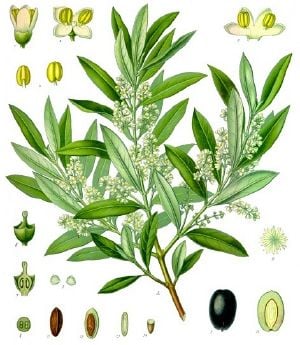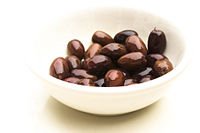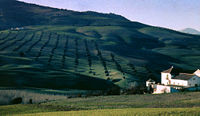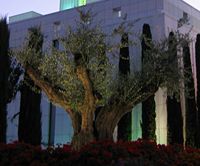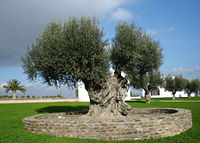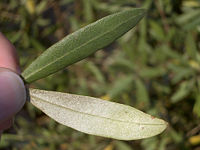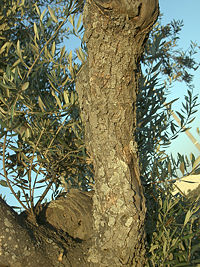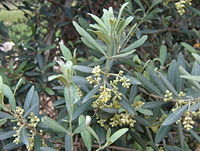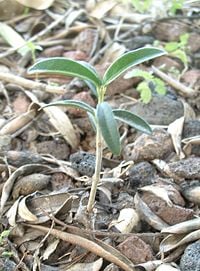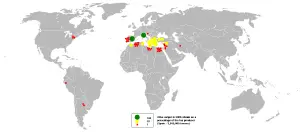Olive
- This article is about the tree; for its edible fruit, see Olive (fruit); for other uses, see Olive (disambiguation).
- "Olive tree" redirects here; for other uses, see The Olive Tree.
| Olive | ||||||||||||||
|---|---|---|---|---|---|---|---|---|---|---|---|---|---|---|
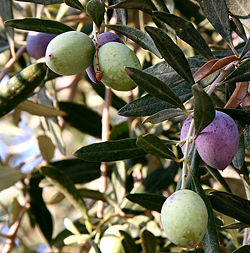 | ||||||||||||||
| Scientific classification | ||||||||||||||
| ||||||||||||||
| Olea europaea L. |
The Olive (Olea europaea) is a species of small tree in the family Oleaceae, native to coastal areas of the eastern Mediterranean region, from Syria and the maritime parts of Asia Minor and northern Iran at the south end of the Caspian Sea. Its fruit, the olive, is of major agricultural importance in the Mediterranean region as the source of olive oil.
Description
The Olive is an evergreen tree or shrub native to the Mediterranean, Asia and parts of Africa. It is short and squat, and rarely exceeds 8-15 meters in height.
The silvery green leaves are oblong in shape, measuring 4-10 cm long and 1-3 cm wide. The trunk is typically gnarled and twisted.
The small white flowers, with four-cleft calyx and corolla, two stamens and bifid stigma, are borne generally on the last year's wood, in racemes springing from the axils of the leaves.
The fruit is a small drupe 1-2.5 cm long, thinner-fleshed and smaller in wild plants than in orchard cultivars. Olives are harvested at the green stage or left to ripen to a rich purple color (black olive). Canned black olives may contain chemicals that turn them black artificially.
History
The olive is one of the plants most cited in recorded literature. In Homer's Odyssey, Odysseus crawls beneath two shoots of olive that grow from a single stock.[1] The Roman poet, Horace mentions it in reference to his own diet, which he describes as very simple: "As for me, olives, endives, and smooth mallows provide sustenance."[2] Lord Monboddo comments on the olive in 1779 as one of the foods preferred by the ancients and as one of the most perfect foods.[3]
Old trees
Pliny the Elder told of a sacred Greek olive tree that was 1600 years old. Several trees in the Garden of Gethsemane (from the Hebrew words "gat shemanim" or oil press) in Jerusalem are claimed to date back to the time of Jesus.[4] Some Italian olive trees are believed to date back to Roman times, although identifying progenitor trees in ancient sources is difficult.
However, the age of an olive tree in Crete, claimed to be over 2,000 years old, has been determined on the basis of tree ring analysis.[5] Another, on the island of Brijuni (Brioni), Istria in Croatia, a well-known olive tree has been calculated to be about 1,600 years old. It still gives fruit (about 30 kg per year), which is made into top quality olive oil. [6] The olive tree is one of the symbols of Athena, the Greek goddess, and is frequently mentioned in the Bible and the Qur'an.
Cultivation and uses
The olive has been cultivated since ancient times as a source of olive oil, fine wood, and olives for consumption. The fruit, naturally bitter, typically subjected to fermentation or cured with lye or brine to make it more palatable.
Green olives and black olives are soaked in a solution of sodium hydroxide and washed thoroughly in water to remove oleuropein, a naturally bitter carbohydrate.
Green olives are allowed to ferment before being packed in a brine solution. American black ("California") olives are not fermented, which is why they taste milder than green olives.
It is not known when olives were first cultivated for harvest. Among the earliest evidence for the domestication of olives comes from the Chalcolithic Period archaeological site of Teleilat Ghassul in what is today modern Jordan.
The plant and its products are frequently referred to in the Bible, the Qur'an and by the earliest recorded poets. Farmers in ancient times believed olive trees would not grow well if planted more than a short distance from the sea; Theophrastus gives 300 stadia (55.6 km) as the limit. Modern experience does not always confirm this, and, though showing a preference for the coast, it has long been grown further inland in some areas with suitable climates, particularly in the southwestern Mediterranean (Iberia, northwest Africa) where winters are milder.
Olives are now cultivated in many regions of the world such as South Africa, Australia, New Zealand, Mediterranean Basin and California. Considerable research has been accumulated supporting the health benefits of consuming olives and olive oil (see external links below for research results).
The olive tree provides leaves, fruit and oil. Olive leaves are used in medicinal teas.
Subspecies
There are at least five natural subspecies distributed over a wide range:
- Olea europaea subsp. europaea (Europe)
- Olea europaea subsp. cuspidata (Iran to China)
- Olea europaea subsp. guanchica (Canaries)
- Olea europaea subsp. maroccana (Morocco)
- Olea europaea subsp. laperrinei (Algeria, Sudan, Niger)
Cultivars
There are thousands of cultivars of the olive. In Italy alone at least three hundred cultivars have been enumerated, but only a few are grown to a large extent. The main Italian cultivars are 'Leccino', 'Frantoio' and 'Carolea'. None of these can be safely identified with ancient descriptions, though it is not unlikely that some of the narrow-leaved cultivars most esteemed may be descendants of the Licinian olive. The Iberian olives are usually cured and eaten, often after being pitted, stuffed (with pickled pimento, onion, or other garnishes) and jarred in fresh brine.
Since many cultivars are self sterile or nearly so, they are generally planted in pairs with a single primary cultivar and a secondary cultivar selected for its ability to fertilize the primary one, for example, 'Frantoio' and 'Leccino'. In recent times, efforts have been directed at producing hybrid cultivars with qualities such as resistance to disease, quick growth and larger or more consistent crops.
Some particularly important cultivars of olive include:
- 'Frantoio' and 'Leccino'. These cultivars are the principal participants in Italian olive oils from Tuscany. Leccino has a mild sweet flavour while Frantoio is fruity with a stronger aftertaste. Due to their highly valued flavour, these cultivars have been migrated and are now grown in other countries.
- 'Arbequina' is a small, brown olive grown in Catalonia, Spain. As well as being used as a table olive, its oil is highly valued.
- 'Empeltre' is a medium sized, black olive grown in Spain. They are used both as a table olive and to produce a high quality olive oil.
- 'Kalamata' is a large, black olive, named after the city of Kalamata, Greece, used as a table olive. These olives are of a smooth and meatlike taste.
- 'Koroneiki' originates from the southern Peloponese, around Kalamata and Mani in Greece. This small olive, though difficult to cultivate, has a high oil yield and produces olive oil of exceptional quality.
- 'Pecholine' or 'picholine' originated in the south of France. It is green, medium size, and elongated. Their flavour is mild and nutty.
- 'Lucques' originated in the south of France (Aude département). They are green, of a large size, and elongated. The stone has an arcuated shape. Their flavour is mild and nutty.
- 'Souri' (Syrian) originated in Lebanon and is widespread in the Levant. It has a high oil yield and exceptionally aromatic flavour.
- 'Nabali' is a Palestinian cultivar[7] also known locally as 'Baladi', which along with 'Souri' and 'Malissi' are considered to produce among the highest quality olive oil in the world.[8]
- 'Barnea' is a modern cultivar bred in Israel to be disease resistant and to produce a generous crop. It is used both for oil and for table olives. The oil has a strong flavour with a hint of green leaf. Barnea is widely grown in Israel and in the southern hemisphere, particularly in Australia and New Zealand.
- 'Maalot' is another modern, disease-resistant, Eastern Mediterranean cultivar derived from the North African 'Chemlali' cultivar. The olive is medium sized, round, has a fruity flavour and is used almost exclusively for oil production.
- 'Mission' originated on the California Missions and is now grown throughout the state. They are black and generally used for table consumption.
Growth and propagation
Olive trees show a marked preference for calcareous soils, flourishing best on limestone slopes and crags, and coastal climate conditions. They tolerate drought well, thanks to their sturdy and extensive root system. Olive trees can be exceptionally long-lived, up to several centuries, and can remain productive for as long, provided they are pruned correctly and regularly.
The olive tree grows very slowly, but over many years the trunk can attain a considerable diameter. A. P. de Candolle recorded one exceeding 10 m in girth. They can possibly reach great age and the trees rarely exceed 15 m in height, and are generally confined to much more limited dimensions by frequent pruning. The yellow or light greenish-brown wood is often finely veined with a darker tint; being very hard and close-grained, it is valued by woodworkers.
The olive is propagated in various ways, but cuttings or layers are generally preferred; the tree roots easily in favourable soil and throws up suckers from the stump when cut down. However, yields from trees grown from suckers or seeds are poor; it must be budded or grafted onto other specimens to do well (Lewington and Parker, 114). Branches of various thickness are cut into lengths of about 1 m and, planted deeply in manured ground, soon vegetate; shorter pieces are sometimes laid horizontally in shallow trenches, when, covered with a few centimetres of soil, they rapidly throw up sucker-like shoots. In Greece, grafting the cultivated tree on the wild form is a common practice. In Italy, embryonic buds, which form small swellings on the stems, are carefully excised and planted beneath the surface, where they grow readily, their buds soon forming a vigorous shoot.
Occasionally the larger boughs are marched, and young trees thus soon obtained. The olive is also sometimes raised from seed, the oily pericarp being first softened by slight rotting, or soaking in hot water or in an alkaline solution, to facilitate germination.
Where the olive is carefully cultivated, as in Languedoc and Provence, the trees are regularly pruned. The pruning preserves the flower-bearing shoots of the preceding year, while keeping the tree low enough to allow the easy gathering of the fruit. The spaces between the trees are regularly fertilized. The crop from old trees is sometimes enormous, but they seldom bear well two years in succession, and in many instances a large harvest can only be reckoned upon every sixth or seventh season.
A calcareous soil, however dry or poor, seems best adapted to its healthy development, though the tree will grow in any light soil, and even on clay if well drained; but, as remarked by Pliny, the plant is more liable to disease on rich soils, and the oil is inferior to the produce of the poorer and more rocky ground.
Fruit harvest and processing
Most olives today are harvested by shaking the boughs or the whole tree. Another method involves standing on a ladder and "milking" the olives into a sack tied around the harvester's waist. Using olives found lying on the ground can result in poor quality oil. In southern Europe the olive harvest is in the winter months, continuing for several weeks, but the time varies in each country, and also with the season and the kinds cultivated. A device called the oli-net wraps around the trunk of the tree and opens to form an umbrella like catcher to catch fruit that is picked. Workers can then harvest the fruit without the weight of the load around their neck. Another device, the oliviera, is an electronic tool that connects to a battery. The oliviera has large tongs that are spun around quickly, removing fruit from the tree. This method is used for olive oil variety olives. Table olive varieties are more difficult to harvest, as workers must take caution not to damage the fruit in any way. Picking baskets that hang around the worker's neck are used.
The amount of oil contained in the fruit differs greatly in the various cultivars; the pericarp is usually 60-70% oil. Typical yields are 1.5-2.2 kg of oil per tree per year.[9]
Olive Oil History
Homer called it "liquid gold." In ancient Greece, athletes ritually rubbed it all over their body. Drops of it seeped into the bones of dead saints and martyrs through holes in their tombs. Olive oil has been more than mere food to the peoples of the Mediterranean: it has been medicinal, magical, an endless source of fascination and wonder and the fountain of great wealth and power. The olive tree, symbol of abundance, glory and peace, gave its leafy branches to crown the victorious in friendly games and bloody war, and the oil of its fruit has anointed the noblest of heads throughout history. Olive crowns and olive branches, emblems of benediction and purifiation, were ritually offered to deities and powerful figures: some were even found in Tutankhamen's tomb.
Traditional fermentation
Olives freshly picked from the tree contain phenolic compounds and a unique glycoside, oleuropein, which makes the fruit unpalatable for immediate consumption. There are many ways of processing olives for table use. Traditional methods use the natural microflora on the fruit and procedures which select for those that bring about fermentation of the fruit. This fermentation leads to three important outcomes: the leaching out and breakdown of oleuropein and phenolic compounds; the creation of lactic acid, which is a natural preservative; and a complex of flavoursome fermentation products. The result is a product which will store with or without refrigeration.
One basic fermentation method is to get food grade containers, which may include plastic containers from companies which trade in olives and preserved vine leaves. Many bakeries also recycle food grade plastic containers which are well sized for olive fermentation; they are 10 to 20 litres in capacity. Freshly picked olives are often sold at markets in 10 kg trays. Olives should be selected for their firmness if green and general good condition. Olives can be used green, ripe green (which is a yellower shade of green, or green with hints of color), through to full purple black ripeness. The olives are soaked in water to wash them, and drained. 7 litres (which is 7 kg) of room temperature water is added to the fermentation container, and 800 g of sea salt, and one cup (300g) of white vinegar (white wine or cider vinegar). The salt is dissolved to create a 10% solution (the 800 g of salt is in a 8 kg mixture of salt and water and vinegar). Each olive is given a single deep slit with a small knife (if small), or up to three slits per fruit (if large, eg 60 fruit per kg). If 10 kg of olives are added to the 10% salt solution, the ultimate salinity after some weeks will be around 5 to 6% once the water in the olives moves into solution and the salt moves into the olives. The olives are weighed down with an inert object such as a plate so they are fully immersed and lightly sealed in their container. The light sealing is to allow the gases of fermentation to escape. It is also possible to make a plastic bag partially filled with water, and lay this over the top as a venting lid which also provides a good seal. The exclusion of oxygen is useful but not as critical as when grapes are fermented to produce wine. The olives can be tasted at any time as the bitter compounds are not poisonous, and oleuropein is a useful antioxidant in the human diet.
The olives are edible within 2 weeks to a month, but can be left to cure for up to three months. Green olives will usually be firmer in texture after curing than black olives. Olives can be flavored by soaking them in various marinades, or removing the pit and stuffing them. Herbs, spices, olive oil, feta, capsicum (pimento), chili, lemon zest, lemon juice, garlic cloves, wine, vinegar, juniper berries, and anchovies are popular flavorings. Sometimes the olives are lightly cracked with a hammer or a stone to trigger fermentation. This method of curing adds a slightly bitter taste.
Pests and diseases
A fungus Cycloconium oleaginum can infect the trees for several successive seasons, causing great damage to plantations. A species of bacterium, Pseudomonas savastanoi pv. oleae[10] induces tumour growth in the shoots, and certain lepidopterous caterpillars feed on the leaves and flowers, while the main damage is made by the olive-fly attacks to the fruit. In France and north-central Italy olives suffer occasionally from frost. Gales and long-continued rains during the gathering season also cause damage. Another pest which spreads through olive trees is the black scale bug. Black scale is a small black beetle that resembles a small black spot. They attach themselves firmly to olive trees and reduce the quality of the fruit. The main predator of black scale is wasps.
Economy
Production
Olive is the most extensively cultivated fruit crop in the world.[11] Its cultivation areas has tripled in the past 44 years, passing from 2.6 to 8.5 million of hectares.
The first ten countries of production, as per FAO, all located in the Mediterranean region, represent together 95% of the world production of olives.
| Rank | Country/Region | Production (in tons) |
Cultivated area (in hectares) |
Yield (q/Ha) |
|---|---|---|---|---|
| — | World | 17,317,089 | 8,597,064 | 20.1 |
| 1 | Spain | 6,160,100 | 2,400,000 | 25.7 |
| 2 | Italy | 3,149,830 | 1,140,685 | 27.6 |
| 3 | Greece | 2,400,000 | 765,000 | 31.4 |
| 4 | Turkey | 1,800,000 | 594,000 | 30.3 |
| 5 | Syria | 998,988 | 498,981 | 20.0 |
| 6 | Tunisia | 500,000 | 1,500,000 | 3.3 |
| 7 | Morocco | 470,000 | 550,000 | 8.5 |
| 8 | Egypt | 318,339 | 49,888 | 63.8 |
| 9 | Algeria | 300,000 | 178,000 | 16.9 |
| 10 | Portugal | 280,000 | 430,000 | 6.5 |
| 11 | Lebanon | 180,000 | 230,000 | 4.5 |
Olive as an invasive weed
Since its first domestication, Olea europaea has been spreading back to the wild from planted groves. Its original wild populations in southern Europe have been largely swamped by feral plants.[12]
In some other parts of the world where it has been introduced, most notably South Australia, the Olive has become a major woody weed that displaces native vegetation. Its seeds are spread by the introduced Red Fox and by many bird species including the European Starling and the native Emu into woodlands where they germinate and eventually form a dense canopy that prevents regeneration of native trees.[13]
See also
- Oil-tree
- Olive (fruit)
- Phytonutrient
- Polyphenol antioxidant
- Olive leaf
Notes
- ↑ Homer, "Odyssey, book 5," ca 800B.C.E.
- ↑ "Me pascunt olivae, me cichorea levesque malvae." Horace, Odes 1.31.15, ca 30 B.C.E.
- ↑ Letter from Lord Monboddo to John Hope, 29 April, 1779; reprinted by William Knight 1900 ISBN 1-85506-207-0
- ↑ Lewington, A., & Parker, E. (1999) Ancient Trees., pp 110-113, London: Collins & Brown Ltd. ISBN 1-85585-704-9
- ↑ O. Rackham, J. Moody, The Making of the Cretan Landscape, 1996, cited in F. R. Riley (2002). Olive Oil Production on Bronze Age Crete: Nutritional properties, Processing methods, and Storage life of Minoan olive oil. Oxford Journal of Archaeology 21 (1): 63-75
- ↑ Old Olive Tree. Brijuni National Park. Retrieved 2007-03-10.
- ↑ Belaj et al. (September 2002). Genetic diversity and relationships in olive (Olea europaea L.) germplasm collections as determined by randomly amplified polymorphic DNA. 'TAG Theoretical and Applied Genetics' Volume 105, Number 4.
- ↑ PFTA & Canaan Fair Trading. A Brief Study of Olives and Olive Oil in Palestine. Zatoun. Retrieved 2007-08-31.
- ↑ Riley, op.cit.
- ↑ Janse, J. D. 1982. Pseudomonas syringae subsp. savastanoi (ex Smith) subsp. nov., nom. rev., the bacterium causing excrescences on Oleaceae and Nerium oleander L. Int. J. Syst. Bacteriol. 32:166-169.
- ↑ FAO, 2004
- ↑ Lumaret, R. & Ouazzani, N. (2001) Ancient wild olives in Mediterranean forests. Nature 413: 700
- ↑ Dirk HR Spennemann & Allen, L.R. (2000) Feral olives (Olea europaea) as future woody weeds in Australia: a review. Australian Journal of Experimental Agriculture 40: 889-901.
External links
- The Olive Tree World
- Olive germplasm
- Plants for a Future: Olea europaea
- International Olive Oil Council Includes studies on health benefits
- The history and gastronomy of the olive and olive oil in Spain
- Greek Olives and Olive Oil: History, cultivation, production and marketing
- How to pickle olives
- Pickling Olives the Mediterranean Way
Credits
New World Encyclopedia writers and editors rewrote and completed the Wikipedia article in accordance with New World Encyclopedia standards. This article abides by terms of the Creative Commons CC-by-sa 3.0 License (CC-by-sa), which may be used and disseminated with proper attribution. Credit is due under the terms of this license that can reference both the New World Encyclopedia contributors and the selfless volunteer contributors of the Wikimedia Foundation. To cite this article click here for a list of acceptable citing formats.The history of earlier contributions by wikipedians is accessible to researchers here:
The history of this article since it was imported to New World Encyclopedia:
Note: Some restrictions may apply to use of individual images which are separately licensed.
